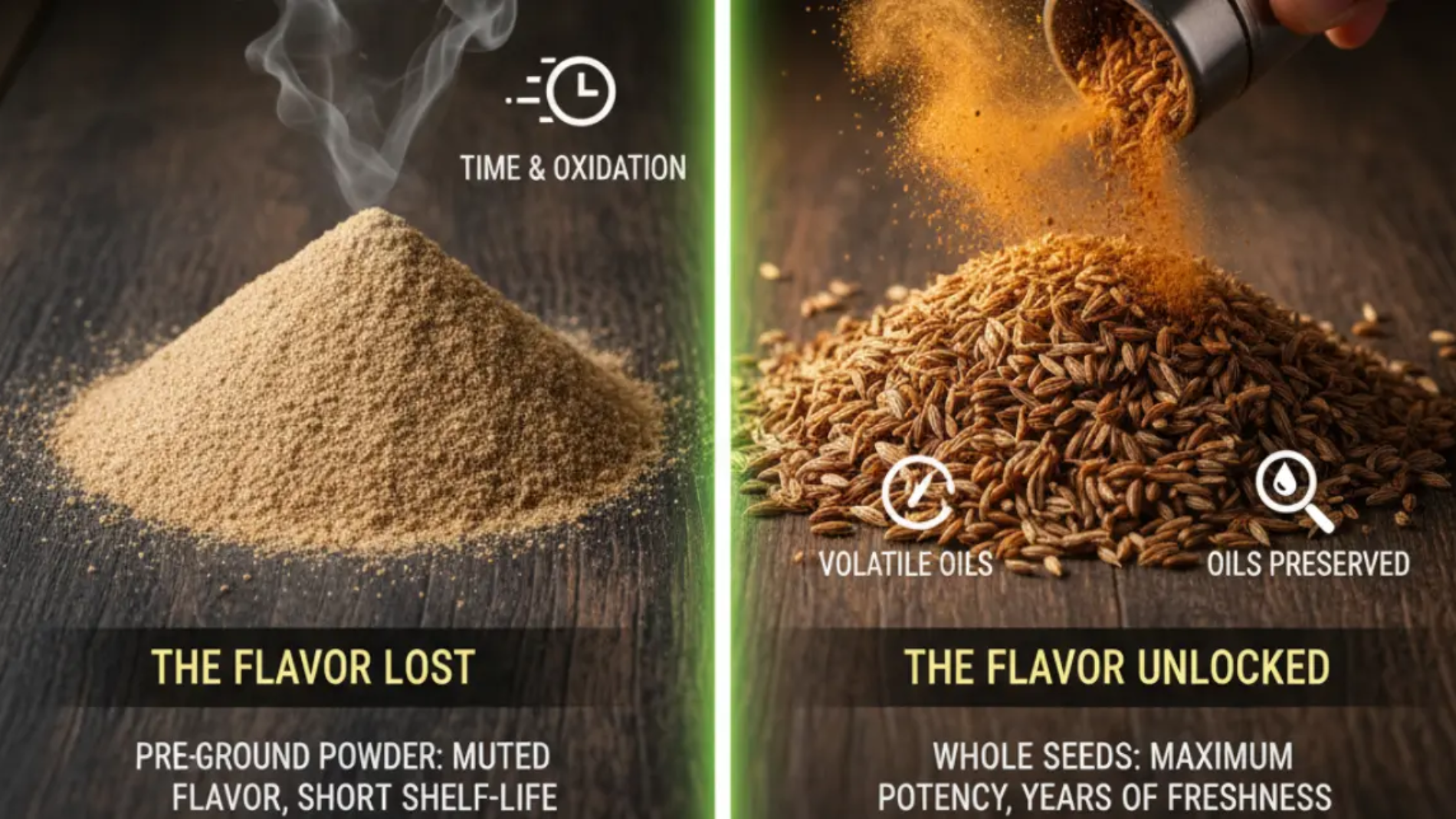In the world of food manufacturing, no product is more fundamental to flavor than the spice blend. A signature curry powder, a taco seasoning, or a complex ras el hanout is the heart of a brand, and its consistency is its bond of trust with the consumer. To create these premium blends, R&D teams and professional spice blenders must make a critical choice: do they use pre-ground cumin powder or start with whole cumin seeds?
While pre-ground powder offers convenience, the world’s best food manufacturers and spice artisans know a non-negotiable secret: the most vibrant, potent, and stable spice blends always start with the whole cumin spice.
As a leading cumin exporter in India, we understand the technical and sensory advantages behind this decision. Here is the B2B case for why sourcing whole cumin seeds is the superior choice for your product line.
1. The Flavor Lock: Protecting Volatile Oils
The “flavor” of any spice is a direct result of its volatile oils. These delicate aromatic compounds are the very essence of the spice. A whole cumin seed is a perfect, natural, airtight container, designed by nature to protect these oils from oxidation and evaporation.
The moment a cumin seed is ground into ground cumin or jeera powder, its surface area increases exponentially. This exposes those precious oils to air and light, and they immediately begin to degrade. A pre-ground powder that has been processed, packaged, shipped, and stored for months will have lost a significant portion of its aromatic potency.
For a spice blender, this is the most important factor. Grinding whole seeds in-house, just before blending, shatters the seed and releases a “burst” of potent, fresh flavor that pre-ground powder simply cannot match. This results in a final product that is far more fragrant and impactful.
2. The Shelf-Life Advantage: A Smarter Investment
For an importer or food manufacturer, inventory is an investment. Shelf life is profit.
Whole Cumin Seeds: When stored correctly in a cool, dark place, whole seeds can retain their peak quality and volatile oil content for several years. They are robust, stable, and a low-risk inventory item.
Cumin Powder: Pre-ground powder’s shelf life is measured in months, not years. Its flavor and aroma degrade rapidly.
By sourcing whole cumin seeds, a manufacturer is making a more stable financial investment. They reduce the risk of product spoilage, ensure their inventory remains potent for longer, and guarantee that the last bag of their spice blend tastes just as fresh as the first.
Spice Up Your Business with Authentic Indian Flavors
Import and Export Excellence from India!

3. Absolute Control Over Purity and Adulteration
Purity is a non-negotiable in the B2B food world. The pre-ground powder market is notoriously susceptible to adulteration—the practice of adding “fillers” like rice flour, starches, or even sawdust to bulk up the product and cut costs.
It is extremely difficult to detect these fillers in a fine powder without laboratory testing.
Whole Indian cumin seed, on the other hand, is transparent. A buyer can visually inspect the seeds for quality, consistency, and the absence of foreign matter. By sourcing whole seeds from a trusted supplier in a major hub like the Unjha market, a manufacturer can:
Visually confirm the quality of the raw material.
Guarantee 100% purity in their product.
Protect their brand from the disastrous consequences of adulteration.
4. Total Control Over Texture and Formulation
A spice blend is not just about flavor; it’s also about texture. Different products require different grinds.
A fine, silky jeera powder is perfect for a smooth curry paste or sauce.
A medium, rustic grind is ideal for a steak rub or a “rustic” seasoning blend.
A coarse-cracked seed is used for pickling spices or as a “topper.”
When a manufacturer buys pre-ground powder, they are locked into one particle size. By sourcing whole cumin seeds, the R&D team and food formulators have complete control. They can customize the grind to perfectly match the specific textural and sensory requirements of their new product, giving them a level of precision that is essential for innovation.
Why "Whole" is the Professional's Choice
While cumin powder has its place, it is a product of convenience. For businesses where quality, potency, and consistency are the cornerstones of their brand, the choice is clear.
The best spice blends start with whole cumin spice because it provides unparalleled flavor, a vastly superior shelf life, a guarantee of purity, and complete control over the final product. The foundation of any great blend is a high-quality, high-purity raw material. To ensure your products start with the best, you need a reliable partner who can deliver that quality, every single time.
Frequently Asked Questions (FAQs)
1. What is the real flavor difference between fresh-ground and pre-ground cumin?
Freshly ground cumin has a much stronger, brighter, and more complex aromatic flavor. Pre-ground cumin, especially if old, will taste flatter, dustier, and more muted, as its most fragrant volatile oils have evaporated.
2. Is it more cost-effective to buy whole cumin seeds?
While the initial purchase price may be similar, it is often more cost-effective in the long run. You get a more potent product (so you may be able to use less), you have zero waste from spoilage due to its long shelf life, and you are protected from the financial risk of adulteration.
3. What is “jeera powder”?
“Jeera” is the Hindi name for cumin. “Jeera powder” is the exact same thing as ground cumin or cumin powder.
4. How can I tell if whole cumin seeds are high-quality?
Look for seeds that are uniform in color (a light brownish-yellow), plump, and relatively free of sticks, stems, and broken seeds. The most important test is the aroma: crush a few seeds between your fingers. They should release a strong, warm, and pungent fragrance.
5. What is the difference between brown cumin and black cumin?
This is a critical distinction. Brown cumin (Cuminum cyminum) is the common “jeera” this article discusses. Black Cumin (Nigella sativa, or Kalonji) is a completely different spice with a pungent, peppery, and slightly bitter taste. They are not interchangeable.
6. Why is Indian cumin seed considered a global benchmark?
Indian cumin seed, particularly from the Unjha market in Gujarat, is the global benchmark for quality and trade. India is the world’s largest producer, offering a consistent, aromatic product with a high volatile oil content that is prized by spice blenders worldwide.
7. What is the best way to grind whole cumin seeds?
For commercial production, a water-cooled or cryogenic spice grinder is used to prevent heat from destroying the volatile oils. For smaller test batches, a burr grinder is ideal.
8. What’s the best way to store bulk cumin seeds?
Store them in a cool, dark, and dry place in airtight, food-grade containers. Keep them away from heat, light, and moisture to protect the volatile oils and ensure a multi-year shelf life.
About us
We bridge the gap between local producers and global markets, ensuring seamless trade facilitation with exceptional quality and reliability. We provide quick delivery services with customized packaging with all approval of International Certificates (Spices board India, MSME, IEC, fssai, FIEO, APEDA, EU certification, FDA and Many More)
Contact us
Shop No. 3, Ganesh Prestige Sr. No. 2/15, Near Laxmi Jewellers, Dhanakawadi, Pune – 411043, Maharashtra INDIA.
Call On
+91 9545205050
+91 9822422584



Leave A Comment